20 | English
Basic speed setting at level
1 2 3
[min
-1
] [min
-1
] [min
-1
]
Number of speed settings
3
0–1 100 0–2 300 0–3 400
You can use the button for speed preselection (19) to
preselect the required speed, even during operation.
Selecting the working mode
The power tool has two preset working modes A and B (16).
You can also programme working modes for different applic-
ations and adjust existing modes via the Bosch Toolbox un-
der A and B (16).
To switch between the working modes A and B (16), press
the mode button (17).
Practical advice
u Only apply the power tool to the screw/nut when the
tool is switched off. Rotating tool inserts can slip off.
u The power tool with inserted Bluetooth
®
Low Energy
ModuleGCY42 (accessory) is equipped with a radio
interface. Local operating restrictions, e.g. in aircraft
or hospitals, must be observed.
The torque depends on the impact duration. The maximum
achieved torque results from the sum of all individual
torques achieved through impact. Maximum torque is
achieved after an impact duration of 6–10seconds. After
this duration, the tightening torque increases only minimally.
The impact duration is to be determined for each required
tightening torque. The tightening torque actually achieved
should always be checked with a torque wrench.
Screw applications with hard, spring-loaded or soft seats
When the achieved torques in an impact series are measured
during a test and transferred into a diagram, the result is the
curve of a torque characteristic. The height of the curve cor-
responds with the maximum reachable torque, and the
steepness indicates the duration in which this is achieved.
A torque gradient depends on the following factors:
– Strength properties of the screws/nuts
– Type of backing (washer, disc spring, seal)
– Strength properties of the material being screwed/bolted
together
– Lubrication conditions at the screw/bolt connection
The following application cases result accordingly:
– A hard seat is a metal-to-metal screw application which
uses washers. After a relatively short impact duration, the
maximum torque is reached (steep characteristic curve).
Unnecessary long impact duration only causes damage to
the machine.
– A spring-loaded seat is also a metal-to-metal screw ap-
plication but uses spring washers, disc springs, studs or
screws/nuts with conical seats. It is also called a spring-
loaded seat when extensions are used.
– A soft seat is a screw application of e.g. metal on wood or
a screw application that uses lead washers or fibre wash-
ers as backing.
For a spring-loaded seat as well as for a soft seat, the max-
imum tightening torque is lower than for a hard seat. Also, a
clearly longer impact duration is required.
Guide values for maximum screw tightening torques
Figures given in Nm; calculated from the tensional cross-section; utilization of the yield point: 90% (with friction coefficient
µ
total
=0.12). As a control measure, always check the tightening torque with a torque wrench.
Property Classes
according to
DIN267
Standard Screws/Bolts High-strength Bolts
3.6 4.6 5.6 4.8 6.6 5.8 6.8 6.9 8.8 10.9 12.9
M6 2.71 3.61 4.52 4.8 5.42 6.02 7.22 8.13 9.7 13.6 16.2
M8 6.57 8.7 11 11.6 13.1 14.6 17.5 19.7 23 33 39
M10 13 17.5 22 23 26 29 35 39 47 65 78
M12 22.6 30 37.6 40 45 50 60 67 80 113 135
M14 36 48 60 65 72 79 95 107 130 180 215
M16 55 73 92 98 110 122 147 165 196 275 330
Tips
Before screwing larger, longer screws into hard materials, it
is advisable to pre-drill a pilot hole with the core diameter of
the thread to approx. 2/3 of the screw length.
Note: Ensure that no metal particles enter the power tool.
After working at a low speed for an extended period, you
should operate the power tool at the maximum speed for ap-
proximately three minutes without load to cool it down.
Recommendations for optimal handling of the battery
Protect the battery against moisture and water.
Only store the battery within a temperature range of -20 to
50 °C. Do not leave the battery in your car in the summer, for
example.
A significantly reduced operating time after charging indic-
ates that the battery has deteriorated and must be replaced.
Follow the instructions on correct disposal.
Belt clip
You can use the belt clip (3) to hang the power tool on a belt,
for example. You then have both hands free and the power
tool is always at hand.
1 609 92A 5TB | (06.05.2021) Bosch Power Tools
